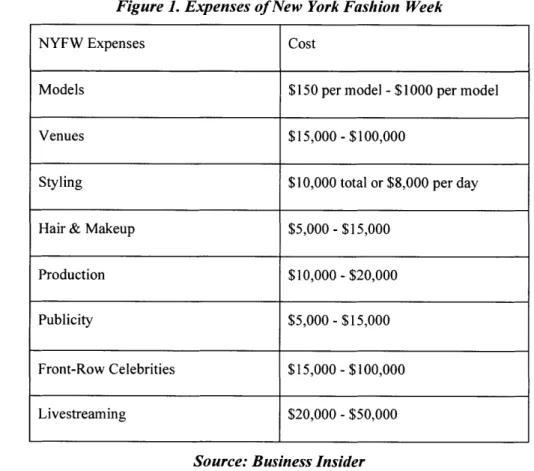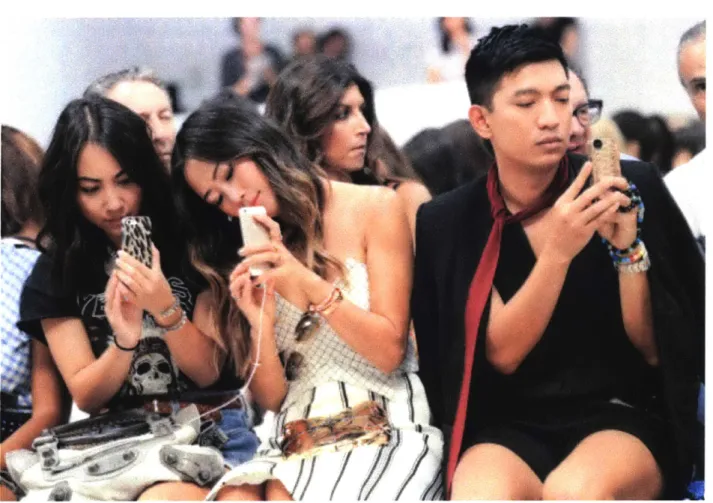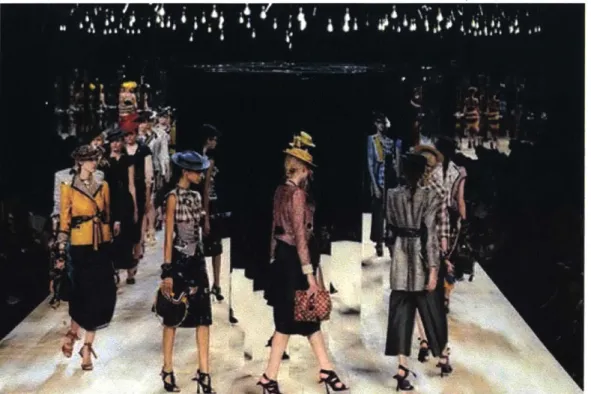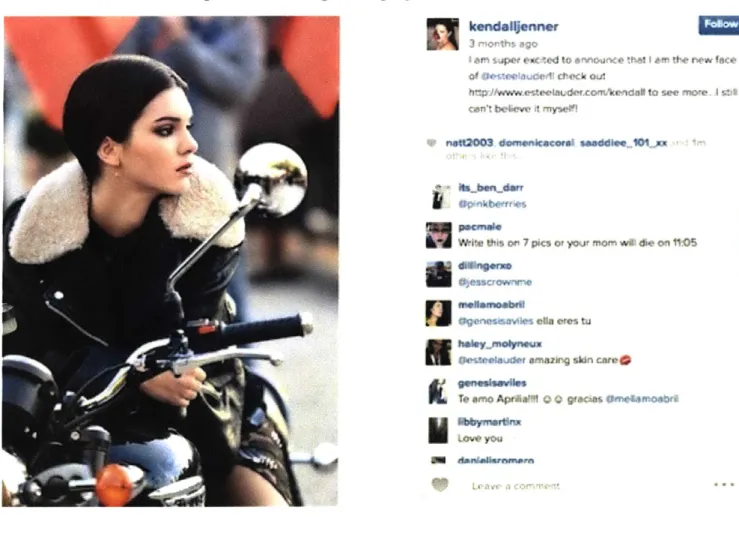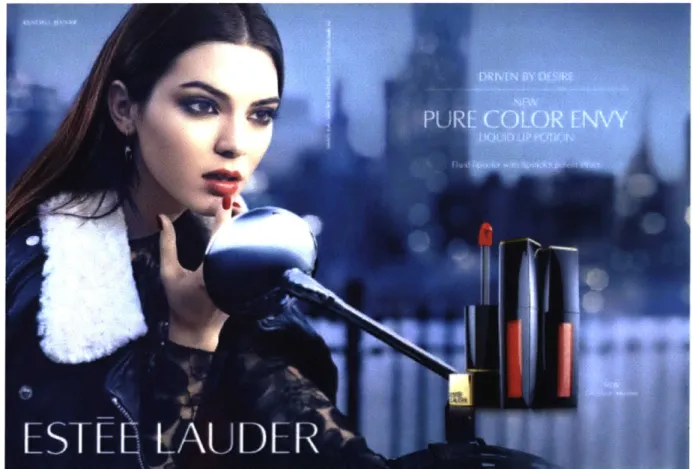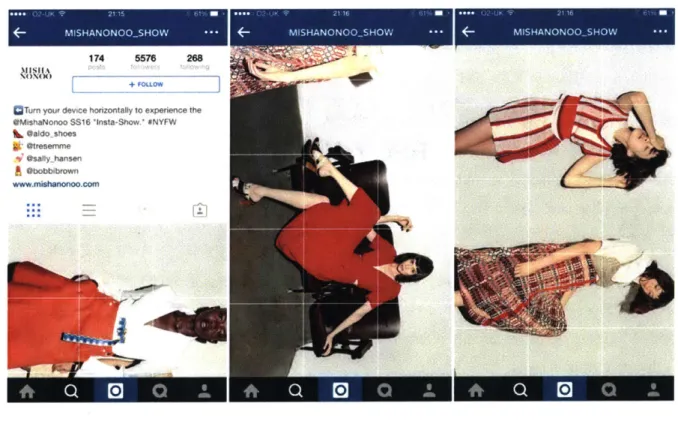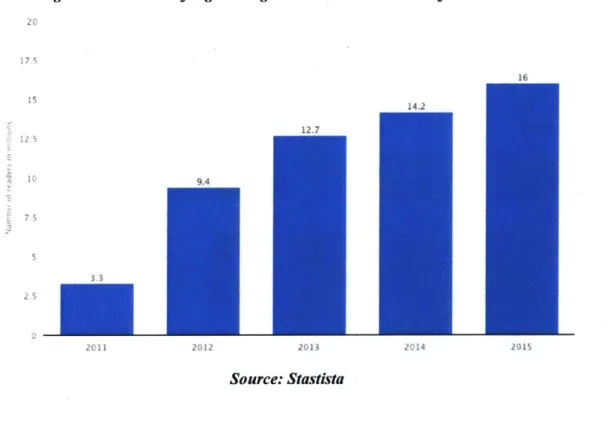The Disruptive Impact of Technology on the Fashion Industry
ByJAYEON KIM
SUBMITTED TO THE MIT SLOAN SCHOOL OF MANAGEMENT IN PARTIAL
FULFILLMENT OF THE REQUIREMENTS FOR THE DEGREE OF
MASTER OF BUSINESS ADMINISTRATION
AT THE
MASSACHUSETTS INSTITUTE OF TECHNOLOGY
JUNE 2017
C2017 Jayeon Kim. All rights reserved.
The author hereby grants to MIT permission to reproduce
and to distribute publicly paper and electronic
copies of this thesis document in whole or in part
in any medium now known or hereafter created.
Signature of Author:
Signature redacted
7N\>2
Certified by:
MIT Sloan School of Management
May 12, 2017
Signature redacted
Duncan Simester
Thesis Supervisor
Accepted by:
Signature redacted
/
Johanna Hising DiFabio
Director, Sloan Fellows and EMBA Programs
MIT Sloan School of Management
MASSACHUSETS INSTITUTE OF TECHNOLOGY
JUN 2 0
2017
LIBRARIES
ARCHIVES
The Disruptive Impact of Technology on the Fashion Industry
By
JAYEON KIM
Submitted to MIT Sloan School of Management on May 12, 2017 in Partial Fulfillment of the
requirements for the Degree of Master of Business Administration.
ABSTRACT
The rules of the power game are shifting in the fashion industry due to technology. High-end fashion brands are faced with a significant disruption because of the forces of media and technology. Traditionally, fashion trends trickled down from high-end fashion to lower-end fashion or mass fashion. High-end luxury fashion brands once wielded absolute power as trendsetters, and mass brands followed the trends set by exclusive brands. Traditional high-end print fashion magazines such as Vogue and
Harper 's Bazaar were powerful sources of information about upcoming fashion trends.
However, technology is changing every element of this power structure. Luxury brands and high-end fashion magazines no longer have the absolute power as fashion trhigh-endsetters that they once enjoyed. In this new era, the ability to adapt to digital and technology trends will be the key solution for fashion brands to maintain their traditional power. This thesis is an exploration into three sectors of disruption: Fashion Week Cycle, Fashion Communication, and Fashion Retailers. In this thesis, I analyze and discuss how technology has been disrupting the fashion industry and suggest possible solutions and strategies for traditional players who want to regain their standing.
Thesis Supervisor: Duncan Simester Title: NTU Professor of Marketing
Acknowledgements
My deep gratitude goes first to Professor Duncan Simester, who expertly guided me through my
graduate education at MIT Sloan School of Management and gave me insight into the world of channel and firm design. I am sincerely grateful that he provided me with numerous sessions for dissecting management concepts.
My appreciation also extends to my Sloan Fellows, numerous friends, mentors, and professors
who have helped me by patiently participating in discussions and answering my questions. This thesis benefited from the efforts of many people. I am also thankful to all such people who have been supporting me in this journey.
Above all, I would like to acknowledge with gratitude, the support and love of my family and my friends, who always fully support me and allow me to pursue my dreams. They all kept me going, and this thesis would not have been possible without them.
Table of Contents
Parti. The Change of Fashion Cycle:
Traditional Fashion Weeks versus "See-Now-Buy-Now" Collections
Background
1. The Traditional Fashion Cycle ...
11
2. The Traditional Fashion Week Shows ...
11
3. The Social Media Impact on the Fashion Industry...13
1) Power Growing of Social Media ...
13
2) Rising of Social Media Influencers ...
14
4. The Disruption of Fashion Week ...
18
1) In season fashion shows: "See-Now-Buy-Now" ...
18
2) Social Media Fashion Shows...20
Conclusion & Strategic Implication ...
21
Part2. Fashion Communications:
Traditional Fashion Magazines versus Digital Media
Background
1. The Traditional Fashion Magazine ...
22
2. The Digitalization Impact on Fashion Publication ...
22
2-1. The Disruption of Traditional Fashion Publication ...
23
1) Growth of Digital Magazines ...
23
2) Digital Failure of LUCKY Magazine ...
24
2-2. Influencing Power Changes of Traditional Fashion Magazines ...
26
1) Power Shifts from Fashion Editors to Fashion Bloggers ...
26
2) Fashion Bloggers' Influencing Impact of Consumer Buying Behavior ... 27
3) Influencing Power of Fashion Magazines Versus Social Media Influencers ... 28
Part3. Fashion Retailers:
Traditional Department Stores versus Online Retailers
Background
1. The Complexity of Retail Industry ...
31
2. Traditional Department Stores ...
32
1) Sales Trend of Department Stores ...
32
2) Can Digitalization of Luxury Department Stores Beat Online Retailers?
... 33
3. The Disruptive Online Retailer: YOOX Net-a-Porter(YNAP) ...
36
1) About YOOX Group ...
36
2) About Net-a-Porter ...
37
3) Merger: Yoox Net-a-Porter ...
37
4) Yoox-Net-A-Porter Omni Channel Strategy...
38
Conclusion & Strategic Implication ...
43
Part4. Conclusion
C on clusion ...
44
List of Figures
Figure
1.
Expenses of New York Fashion Week... 12Figure 2. Projected number of social network users in the United States from 2015 to 2021... 13
Figure 3. Social media activities of internet users who connected with brands in the United States as of 3rd quarter 2 016 ... 14
Figure 4. Fashion bloggers holding smartphones at a New York fashion week show ... 15
Figure 5. New York Fashion Week Spring/Summer 2009 ... 16
Figure 6. New York Fashion Week Spring/Summer 2016 ... 16
Figure 7. The Instagram Page of Kendall Jenner ... 17
Figure 8. Kendall Jenner as a Brand Ambassador for an Estee Lauder Beauty Campaign ... 18
Figure 9. A "See-Now-Buy-Now" collection ... 19
Figure 10. The Instagram Fashion Show during New York Fashion Week ... 20
Figure 11. Number of digital magazine readers in the U.S. from 2011 to 2015... 23
Figure 12. A Digital Fashion Magazine, DAZED ... 24
Figure 13. Fashion Bloggers are featured on the cover page of Lucky ... 25
Figure 14. Social Media Activities that influenced digital shopping behavior ... 27
Figure 15. Chiara Ferragni's "The Blonde Salad" and her shoes collection ... 29
Figure 16. U.S. Department Store Retail Sales, 2005 - 2015... 32
Figure 17. Nordstrom's Mobile App ... 34
Figure 18. N ordstrom 's iM essage ... 34
Figure 19. A Nordstrom's #OOTD (Outfit of the day) Promotion ... 35
Figure 20. Geographical Distribution of Yoox Net-a-Porter Group Revenue ... 38
Figure 21. Net-a-Porter's Digital Catalogue, The Edit ... 39
Figure 22. Net-a-Porter's Print Magazine, Porter Magazine ... 40
Parti. The Change of Fashion Cycle:
Traditional Fashion Weeks versus "See-Now-Buy-Now" Collections
e
Background
1. The Traditional Fashion Cycle
A "fashion week" is a fashion industry event, in which fashion designers, brands, or fashion "houses"
present their latest collections in runway shows to buyers and the press. Traditionally, through this event, fashion trend leaders (such as high-end fashion designers, brands, or fashion houses) set or influence trends for the current and upcoming seasons. Fashion designers showcase their fall and winter collections in February and March and present their spring summer collection in September and October. Following these shows, brands start coordinating with suppliers to decide which pieces from the show will be actually produced and at what volume. At the same time, the media requests samples to feature in their publications, and buyers place orders for pieces they wish to carry'. Fashion weeks usually are held four to six months before the season to allow the press and buyers a chance to preview new fashion designs and trends for the following seasons. Fashion weeks are staged in the major fashion capitals of the world, with the most important in New York, London, Milan and Paris; these cities receive the majority of the press coverage. Traditionally, a fashion week was an exclusive event, in which only internal fashion professionals, such as fashion buyers or major fashion media, were invited. The showcases in the major cities influenced other fashion weeks in places such as Berlin, Los Angeles, Sao Paulo, Shanghai, and Tokyo. Fashion weeks were held to drive a fundamental retail cycle, which allowed time for retailers to purchase and leverage designs into their retail marketing and sales some months later.
2. The Traditional Fashion Week Shows
Conventionally, fashion week is a matter of prestige and exclusivity. Only a few high-end fashion designers or brands were able to afford to put on runway shows for the fashion week format because of the high cost.
I
https://www.forbes.com/sites/biancasalonga/2017/02/28/burberrys-buy-now-see-now-february-show-revolutionizes-the-pace-of-luxury-retail/#750ffdec55ae1) The Traditional Model of New York Fashion Week
Designers and brands would spend thousands of dollars on their runway shows. A reasonable amount to participate in a fashion week averages $200,000 or more, depending on a variety of factors2
. Business Insider estimates participants can pay up to $460,000 to participate in the New York Fashion Week.3
Figure 1. Expenses of New York Fashion Week
NYFW Expenses Cost
Models $150 per model -$1000 per model
Venues $15,000 - $100,000
Styling $10,000 total or $8,000 per day
Hair & Makeup $5,000 - $15,000
Production $10,000 -$20,000
Publicity $5,000 -$15,000
Front-Row Celebrities $15,000 -$100,000
Livestreaming $20,000 -$50,000
Source: Business Insider
Although, fashion shows are very costly, designers have been willingly participating for several critical reasons. The first of all, fashion shows have been the venue in which to debut a new season of collection;
4
through fashion shows, designers reveal their products to key buyers and media for the first time Fashion shows have also huge PR effects. All the fashion and lifestyle-specialized press cover them to identify the next big thing. Fashion shows are also a commercial event. Traditionally, buyers of department store or other retailers buy the collections to resell to their consumers around the country or
2 https://www.gobankingrates.com/personal-finance/fashion-week-fuels-new-yorks-economy/ 3 http://www.businessinsider.com/how-much-do-fashion-shows-cost-2013-9
-~
~
--- "aIworld. These buyers decide if a collection is attractive for their consumers. Buyers are the key people to decide merchandise for upcoming season in the fashion market. Moreover, fashion week is a trend event, revealing what will be sold in-store; the buyers can demand variations depending on their influence. However, all of these critical reasons for doing fashion week shows are being diluted due to digital media and technology. Digital and social media have disrupted this retail cycle.
3. The Social Media Impact on the Fashion Industry
1) Power Growth of Social Media
Social media, highly interactive platforms through which individuals, communities and organizations are
5
able to share, co-create, discuss, and modify user-generated content or pre-made content posted online , are becoming more powerful in the digital era. The number of social network users in the United States is expected to rise substantially from 2015 to 2021, according to research by Statista. There were approximately 195.7 million social network users in the United States in 2016, the equivalent of about three quarters of the U.S. population, according to Statista.
Figure 2. Projected number of social network users in the United States from 2015 to 2021 (in millions) 250 200 150 100 50 195.7 0 2015 2016 2017' 2018' 2019' 2020' 2021' Source: Statista 5 https://en.wikipedia.org/wiki/Social-media 3no 7 Wir & io ,
Here are statistics of the social media activities of internet users who communicate with brands in the United States as of the third quarter of 2016, sorted by degree of social media usage 6. According to Statista, even 36 percentage of light social media users mentioned that they followed some of their
7
favorite brands or retailers on social media to find out more about products and services
Figure 3. Social media activities of internet users who connected with brands in the United States as of 3rd quarter 2016
Receive exclusive offers. coupons o' other discount
Show support for my favoritu companies or brands
Rate or review a product or service
Cain access to VIP or members-onI,, evenI 31'-24 125% -3% 3%
I20%
16 0% 5% 10% 15% 20% 25% 3 O' Share of respondents 35% 40% 45%* Light social media users
U
Medium social media users 3 Heavy social media usersSource: Statista
2) Rising of Social Media Influencers
As power of social media grows, the power of social media influencers, digital personalities who have established credibility and have large followings across one or sometimes several social media platforms such as Instagram, You Tube, Snapchat, or on their personal blogs8, is growing as well.
6 https://www.statista.com/statistics/449592/social-media-shopping-activities-brands-usa/ 7 https://www.statista.com/statistics/449592/social-media-shopping-activities-brands-usa/
8 http://mediakix.com/2016/07/social-media-influencers-examples-lists-guide/#gs.GPJczaE
Figure 4. Fashion bloggers holding smartphones at a New York fashion week show
~_
_Social media influencers, who become some of the most powerful individuals in the digital era, are disrupting the fashion industry primarily by smart phone. Previously social media influencers were second-class citizens of the style world, relegated to obscure seats during fashion week. Now they are taking their place in the front row9. Social media influencers such as Chiara Ferragni and Amy Song are sitting next to Anna Wintour10, editor-in-chief of Vogue, while they are wearing clothes provided for free
by designers and earning six-figure brand partnerships with major high-end fashion brands. When social
media influencers attend the fashion week, they take photos of upcoming seasons of brands and send out the images to their millions of social media followers. Scenes of the fashion week are instantly shared and distributed through Instagram, Facebook, and Snapchat. Fashion is now digested much faster: Consumers are no longer willing to wait for the four- to six-month lead time to buy the products they see on social media from fashion week. They want to buy what they see immediately.
9 http://nypost.com/2013/09/05/the-rise-of-the-power-blogger/
Figure 5. New York Fashion Week Spring/Summer 2009
Figure 6. New York Fashion Week Spring/Summer 2016
Although determining whether sales are directly linked to social media campaigns is difficult, companies with higher levels of engagement on Instagram tend grow their online sales faster than their less engaged competitors". It is clear, therefore, that social media influencers are powerful enough to influence consumers' buying behavior, and the number of followers for social media influencers is considered a barometer of their social power. For example, Kendall Jenner 2, an American fashion model and
television personality, has high status as the most-followed model (79.3M followers as of April 2017) on Instagram; this scored her the top job as the face of cosmetics giant Estee Lauder because the company values her as a powerful influencers to its consumers. When Kendall Jenner announced on Instagram that she had been chosen as the brand ambassador of Estee Lauder's new beauty product, she received more than I M "Like's" from her followers within a day.
Figure 7. The Instagram Page of Kendall Jenner ksndljenner
uesocrownwo
o9enesimo.a aftores tu
tknavewubow itwk rWiya#w
"1 http://www.bbc.com/news/business-35483480
12 https://en.wikipedia.org/wiki/Kendall_-Jenner
Figure 8. Kendall Jenner as a Brand Ambassadorfor an Estee Lauder Beauty Campaign
4. The Disruption of Fashion Week
1) In season fashion shows: "See-Now-Buy-Now"
Because of these changes, customer expectations have increased; as a result, the retail cycle is changing as well. Some designers started "in-season shows" in 2016, in which they featured garments available for sale immediately, online or in stores'4. The introduction of "See-Now-Buy-Now" shopping has also come about in response to high street fashion (aka "fast fashion") retailers, who knock off designs from the runway and bring them to retail faster than the high-end fashion".
14 https://www.businessoffashion.com/articles/news-analysis/tom-ford-shifts-show-to-match-retail-cycle
Figure 9. A "See-Now-Buy-Now" collection
Burberry: Burberry is the most pioneering luxury brand, which started a see-now-buy-now collection
early on. Christopher Bailey, a creative director of Burberry, said last year that they would debut a "season-less" collection merging both men's and women's wear, which means merchandise of the collection is available in stores and online shops the day after the fashion show'6.
Tom Ford: In February 2016, this designer decided to follow this trend, saying that because the fashion
world has become increasingly immediate, the current way of showing a collection four months before it is available to consumers is an antiquated idea and no longer makes sense'7. "We have been living with a
fashion calendar and system that is from another era. Our customers today want a collection that is immediately available," he said.
Michael Kors: The designer had a capsule collection in its collection store on Madison Avenue in New
York. The capsule collection included eight pieces that were available for sale right after the runway show. (A capsule collection usually refers to a small collection of items produced to quickly respond to fast changing fashion trends1 8
.)
16 https://www.forbes.com/sites/biancasalonga/2017/02/28/burberrys-buy-now-see-now-february-show-revolutionizes-the-pace-of-luxury-retail/#750ffdec55ae
17 https://www.businessoffashion.com/articles/news-analysis/tom-ford-shifts-show-to-match-retail-cycle
2) Social Media Fashion Shows
Some fashion designers have replaced runway shows with Instagram fashion shows1 9. For example, the New York-based designer Wes Gordon has been running his business mostly through in-person trunk shows and has released short video clips in his Instagram feed instead of participating in the traditional runway format event. The designer says that because the Instagram format is open, he can invite the world to see his work. This means fashion week is no longer a privilege of a group of selected people but a more customer-oriented event. Bureau Betak, a creative director and fashion show producer who has long been leading fashion show productions for many high-end fashion designers, says that this revolution, running at the speed of an Instagram or Snapchat feed, is drastic20. Now if designers can think about an image that will look good in a small square screen or in a ten-second video, anyone with an Instagram account can create their own fashion week. In this way, emerging and younger designers may have more chances to save costs and expand opportunities to broaden their exposure. Thus fashion week is no longer an exclusive and prestigious property for high-end fashion designers and is becoming an accessible, consumer-oriented "event."
Figure 10. The Instagram Fashion Show during New York Fashion Week
174 5576 268
CTum your device horizontally to experience the
*MishaNonoo SS16 'Insta-Show.' #NYFW 6 @aido-shoes g- otresernme ,7 @saflyhansen A Obobbibrown www.mlehanonoo.com -JAi__ 19 https://www.fastcompany.com/3051013/a-fashion-show-steps-off-the-runway-and-onto-instagram 20 http://www.wallpaper.com/fashion/how-social-media-is-reshaping-the-fashion-business#HCXdBoLFr6hg6BYM.99
* Conclusion & Strategic Implication
Social media and social media influencers are disrupting the traditional fashion cycle and the power of the traditional fashion show. The see-now-buy-now collection represents one of the biggest transformations. Thus, I believe high-end brands now require a makeover to keep up with digital trends. However, there are some trade-offs if high-end brands join the alliance of new ways of fashion week.
First of all, the new alliance makes high-end (luxury) fashion lose its exclusivity. Luxury fashion moving into the see-now-buy-now model cannot retain the sense of exclusivity and scarcity that drive true luxury. In addition, more traditional high-end luxury fashion markets such as Paris and Milan are not going to bend over backwards to try to win over customers with a see-now-buy-now collection and Instagram strategy, which goes against the elusive ideal of luxury. Moreover, the see-now-buy-now collection raises delivery issues for fashion brands. In order for the see-now-buy-now collection to be feasible, new merchandise should be shipped stores at least a month before the fashion week. For example, Ford noted that the fall 2016 collection shipped to stores by July sat for over a month after that21. Stores, which carry the collection, had to wait until after the show in September to pull the trigger. In other words, designers who participate in the see-now-buy-now collection must follow a rushed schedule and are impeded by the logistical obstacles of getting deliveries to wholesale partners. The collection may be able to surge sales for department stores or fashion brands' own retailers in the short term, but designers also have to take on the responsibility of restructuring of all supply chain issues that go against the massive task.
A capsule collection, a collection made up of a few pieces, which can be easily combined and
interchanged, can be a real business strategy rather than a reactionary response. The capsule or what New York-based designers term "Ready-to-Wear, Ready to Go" can include apparel, shoes, and handbags. Capsules may reduce the gap in time between full collections being shown on the runway and their delivery by giving consumers the opportunity to select some key items from the runway.
21 http://wwd.com/fashion-news/fashion-features/tom-ford-bids-farewell-to-see-now-buy-now-10845637/
22 http://wwd.com/fashion-news/fashion-features/tom-ford-bids-farewell-to-see-now-buy-now-10845637/
Part2. Fashion Communications:
Traditional Fashion Magazines versus Digital Media
Background
1. The Traditional Fashion Magazine
Fashion magazines have been an important channel in fashion communication. High-end fashion magazines are a major vehicle for highlighting upcoming fashion trends for the next season. Vogue's "influence" is privilege dressed up as "authority." Magazines help to make fashion accessible to consumers by combining symbolic values (they present ideals of beauty and taste, they express the zeitgeist, they are built according to a certain editorial taste, etc.) and material ones (they are products of the editorial industry, they are printed on paper, they sell advertising, etc.)24 .For these reasons, fashion magazines play a critical role as a vehicle for advertising for fashion brands. Even a decade ago, during the early age of the internet, printed publications were considered as the most important tool of the fashion media mix. However, this traditional framework is now radically changing as a result of digitalization and technology.
2. The Digitalization Impact on Fashion Publication
Multifunction devices such as smartphones and tablets are giving fashion consumers radical new avenues to experience fashion. Moreover, consumers are increasingly becoming digitally savvy e-book users, with less reliance on paper products.
Thus, fashion magazines can no longer survive in the digital era producing only paper issues. They need to manage online websites, host blogs, and participate in social networks. As fashion consumers continue to abandon traditional forms of media, many high-end fashion magazines are failing to keep up with the quickening pace of digitally-driven consumers. This is leading to clashes between those who formerly defined the "ins and outs" of the fashion industry and social media influencers who have become the tastemakers for millions25
24 http://gfc-conference.eu/filesdownload/GFC2014/CANIATOFashion-magazines-in-the-digital era.pdf
2-1.
The Disruption of Traditional Fashion Publication
1) Growth of Digital Magazines
Figure 11. Number of digital magazine readers in the U.S. from 2011 to 2015
15
~IC
3.3 2 5 2011 2012 2013 2014 2015 Source: StastistaThe number of digital magazine readers is continuously increasing. While mainstream publications such
as InStyle, Glamour and Cosmopolitan, have shown a consistent drop in circulation, independent digital
magazines such as Dazed, Confused, Love, and V are a growing success
26. Even though these
independent magazines don't have strong brand awareness, their contents and designs with simple
ingredients (contemporary voices and deeper connection with readers) and appeals reflecting new,
avant-garde inspiration, are unfettered by fashion advertising behemoths. However, while Vogue, one of the
biggest portfolios, is successfully approaching its digital platform, most mainstream traditional fashion
magazines are struggling and facing a consistent drop in circulation because they do not adapt to digital
media consumption habits.
26 http://observer.com/2017/0 1/fashion-magazines-face-toughest-times-yet
j
Figure 12. A Digital Fashion Magazine, DAZED
Q Dand tOO N Vi&eo
~2JJ
-A How Prince almost ended up
40 gay men saved from In The Fifth Element
Chechnya's 'gay purge'
smur.
onHw oub &"
rhoSumlanLOU Heusi ti hepad The Purpe One bced out becaum Joi
TM uss=tmLOepb NonI O PA au l iet costwnes W9'O0100
wastng
Nona I L
ms/i
' I==="s=
I,-2) Digital Failure of LUCKY Magazine
Lucky Magazine was a fashion and lifestyle magazine first published in 2000 as a Cond6 Nast subsidiary.
It folded in June 2015 due to its inability to adapt to a digital
2" format. Lucky showcased the best buys for
seasons. The magazine grew to be a significant title and important moneymaker for Cond6 Nest. Many
fashion consumers were able to find the trendiest dress that would otherwise have required hours of
hunting in stores. It turns out the web undercut Lucky's expertise. Everything that the print version of
Lucky once did well, the web magazine format does better. Online-only digital-first enterprises such as
Who What Wear, Refinery29, and POPSUGAR, have stolen Lucky's strong position as a leader of the
28
fashion and beauty magazine . Social media also encouraged other competitors while Lucky did not counter fast enough.
It is true that Lucky made efforts to revamp its sales and boost its reputation. In 2010, Conde Nest recruited Brandon Holley from Yahoo to get Lucky up to speed with its digital game29
. Holley was the
brains behind the successful Lucky FABB conference launched in 2012, an annual digital event that invited the biggest fashion and beauty bloggers and social media stars such as Leandra Medine, known as the Man Repeller for her stylish but daring clothing choices. However, while Holley was digitally savvy, she lacked fashion experience. As a result she resigned due to lack of her fashion creativity. Conde Nest came to believe another creative director was needed30.
Figure 13. Fashion Bloggers are
featured
on the cover page of Lucky Magazinejit
In 2013, Anna Wintour, editor-in-chief of Vogue magazine, brought in Eva Chen, a former editor for
ELLE and Teen Vogue, to bring Lucky into the digital age. Chen was highly visible through her social
media presence. She brought an approachable cool factor with a young sprit to the magazine. Chen took a
28 http://mashable.com/2015/11/03/lucky-magazine-layoffs/#HYHSLeuCVuqz
29 http://mashable.com/2015/11/03/lucky-magazine-layoffs/#5YTFESlgruqk
high-low approach, which features emerging fashion bloggers (social media influencers) in the magazine while recruiting expensive, upscale stylists like Carlyne Cerf de Dudzeele and legendary photographers like Patrick Demarchelier.
Chen's new creative strategy made Lucky look like a digitally savvy magazine, but the upgrade came at a cost. The price points estranged readers who were used to more affordable clothes. Moreover, the publication market continued to slump with poor mailed circulation and newsstand sales that were even
32
worse .Newsstand sales of Lucky magazine fell 15.8% in the first half of 2014 from its peak of 1.1. million to 84,25533
Companies executives decided the brand needed to transition to e-commerce3 4. The site was changed
from LuckyMag.com to LuckyShops.com, which became an editorial site with e-commerce in integration.
However, it turned out that this was an awkward and unsuccessful transition for the fashion editors, who were used to refining copy. They suddenly felt like saleswomen pushing product. Lucky's executives were frustrated by their inability to set the direction for the new online shopping site. In 2015, one month
after Lucky announced the magazine was switched to quarterly, Lucky magazine folded its business3.
2-2. Influencing Power Changes of Traditional Fashion Magazines 1) Power Shifting from Fashion Editors to Fashion Bloggers
Traditional high-end fashion magazines are losing their exclusive influencing power due to fashion bloggers' (social media influencers') accessibility to fashion consumers. In the past, high-end fashion magazine editors such as Vogue editors, were the most powerful influencers of fashion consumers. Today, fashion bloggers have become major members of the fashion world. Their street styles during fashion weeks are constantly featured in mainstream media and they are collaborating with many fashion brands. Fashion bloggers have millions of followers with strong loyalty on their personal blogs and social media. Fashion bloggers are easily accessible to fashion consumers who indicate what they "like" and can leave "comments" detailing their own views. Thus, fashion bloggers are building their strong personal brands
by building their personal fashion styles and constantly sharing their lifestyle. Many fashion bloggers are
not only devoted fashionistas but also skilled content creators who share their thoughts and opinions with
31 https://www.google.com/webhp?sourceid=chrome-instant&ion=1&espv=2&ie=UTF-8#q=anna+wintour
32 http://mashable.com/2015/1 1/03/lucky-magazine-layoffs/#5YTFESlgruqk
33 https://auditedmedia.com
34 http://fashionista.com/2015/02/lucky-shops
I
compelling prose and photos. With their powerful personal content, fashion bloggers attract followers by allowing readers to forge a personal and emotional connection to their style and lifestyle shared in social media. Creating personal emotional connections is one of their advantages; fashion bloggers offer accessibility that fashion editors do not achieve by creating personal connection. When traditional fashion editors write a monthly article, they usually discuss personal experiences based on events that the average person has no access to, which enhances their exclusivity. However, readers now feel less accessible to them.
2) Fashion Bloggers' Influencing Impact on Consumer Buying Behavior
Fashion bloggers are gaining more influence than any other traditional media. According to a survey conducted by Forbes, 33% of millennials review blogs before they make a purchase, compared to fewer than 3% who check TV news, magazines and books 36
. While older generations depend more on
traditional media, millennials look to social media for an authentic look at what's going on in the world, especially content written by their peers whom they trust37.
Figure 14. Social Media Activities that influenced digital shopping behavior
Social Media Activities that influence Their Digital
shop Ing Behavior According to Digital Buyers Wodwide Sep 2015
% of respondents
Readbg review, comnt mund feedback
Raceiv ng Pmnrmonal Offerings
1 30%
StayIng on top of current fetid. and piedct trends
25%
Witing reviews comments and feedack
22%
Aebocletlng with particular bralud or retalers
20%
Pubasing prmducts directly via a social media channel
-6%
Note' n=2.618 ages 18+: SMorIg respondents who conduct each activity
on social media
Sowce PrncewaterhouseCoopers (PwC They Say They Want a Revfoktion:
Tbtal Retal 2016,' Feb 29 2016
Source: PricewaterhouseCoopers(PWC)
36 https://www.forbes.com/sites/danschawbeY/2l5/01/20/10-new-findings-about-the-millennial-consumer/#29e2dl9f6c8f
According to PWC, respondents had shopped online at least once in the past year. Out of 22,618 respondents, approximately half (45%) of digital buyers worldwide said that reading reviews, comments and feedback on social media influenced their digital shopping behavior38
3) Influencing Power of Fashion Magazines Versus Social Media Influencers
Therefore, many fashion brands have decided to expand their marketing budget to influencer marketing because they found influencer marketing is more effective than advertising in magazines. According to a recent Google survey, 84% of marketers responded that they plan on executing at least one influencer marketing campaign in 2017 instead of advertising in magazines39. eConsultancy recently also reported that almost 60% of fashion and beauty brands have an influencer marketing strategy in place. Moreover, these brands also plan to invest another 21% into influencer marketing in 201740. Another new study found that social media influence marketing is 11 times more effective than banner ads1. In other words,
social influencers with accounts with worldwide following are coveted by companies looking to reach plugged-in consumers.
Example 1. Social media Influencer to a business woman: Chiara Ferragni
Chiara Ferragni, a blogger who became an entrepreneur, monetized her personality by turning her online presence into a brand and her millions of followers into a market for her line of products. 42 Chiara Ferragani was a fashionable Italian law student who shared her lifestyle and photography in her blog. She was not a model, actress, or even a traditional celebrity, but today she has two companies worth $8M4 3
.
She also has become a cover girl of all fashion magazines and sits front row at most of New York Fashion Week. Ferragni launched her blog "The Blonde Salad" in October 2009 with her then-boyfriend and current CEO Riccardo Pozzoli while she was studying law at Bocconi University in Milan, Italy44. When
she started to share her fashion and life in her blog, blogging was then very unusual in Italy. She started getting noticed as she received more followers in her social media platforms such as Instagram. She currently has 9 million Instagram followers and 1.2 million "Likes" on her Facebook page as of April
3 https://www.emarketer.com/Article/How-Social-Media-Influences-Shopping-Behavior/1013718 39 http://www.acominfluence.com/blog/10-influencer-marketing-statistics/ 40 https://econsultancy.com/blog/67443-eight-influencer-marketing-stats-for-fashion-beauty-brands/ 4' http://www.cnbc.com/2016/05/20/the-power-of-instagram-brands-eye-more-social-media-influencers.html 42 https://www.theguardian.com/commentisfree/2016/sep/29/the-guardian-view-of-vogue-v-the-bloggers-business-is-winning 4' http://www.cbsnews.com/news/chiara-ferragni-fashion-blogger-became-8-million-dollar-business/ 44 http://www.cbsnews.com/news/chiara-ferragni-fashion-blogger-became-8-million-dollar-business/
2017. The fact that she has millions of followers in the social media led to a host of collaboration with
top-tier luxury brands like Louis Vuitton, which have helped enhance her status as a top fashion influencer'. She leveraged her social reputation (social value) to launch a namesake shoe collection4 6 in
2010, which has a valued net worth of $12M in 201747.
Figure 15. Chiara Ferragni's "The Blonde Salad" and her shoes collection
,HIARA
ABOUT-COLLECTION PRESS CONTAC I - U 45 https://www.businessoffashion.com/articles/business-blogging/business-blogging-blonde-salad 46 https://www.forbes.com/sites/viviennedecker/2015/1 1/03/millenial-chiara-ferragni-from-blonde-salad-blogger-to-shoe-designer/#4e849914ad81 4 7 http://gazettereview.com/2016/06/ten-highest-paid-instagrammers/* Conclusion & Strategic Implication
Traditional high-end print fashion magazines are facing many major challenges in the digital era. Traditional glossy fashion magazines may survive, but their power of influence will shift to the digital side. As a result of revolutionary changes, traditional glossy fashion magazines are losing their exclusivity and influencing power to fashion bloggers. Anna Wintour, Vogue editor-in-chief, once said "Street style challenges high fashion." While Vogue itself depends on close commercial relationships with the major fashion brands, bloggers build their personal brand on being perceived as real people and wearing real clothes, in ways that a consumer could see herself wearing. Fashion bloggers consider themselves self-created celebrities and powerful social influencers48. Moreover, traditional high-end fashion magazines are losing their influencing power to social influencers. As influencers have taken on a more prominent role in the marketing strategies of brands, many fashion brands (or companies) are getting in on the action
by creating platforms to foster partnerships between brands and influencers and track the success of the
resulting campaigns, rather than executing advertising campaign in fashion magazines.
Therefore, fashion magazines should rethink the traditional media paradigm and be more proactive in digitalization. Creating a traditional homepage is not enough, the magazine has to be actively interacting with magazines' readers through social media; this is critical to maintain relationship with their digital savvy readers. In addition, joint ventures between fashion magazines and fashion brands or fashion online retailers can be a better profit model, rather than having fashion magazines transform to e-commerce. Many attempts to transform fashion magazines to e-commerce portals have not been successful. For example, Style.com allows readers to shop the products that readers see in Conde Nast magazines via the rebuilt-from-the-ground-up website. The site is designed so that fashion consumers are able to order merchandise from magazine-branded websites, like Style.com, as well as digitized magazine edition in app form. However, even though fashion magazines have many competitive advantages in creative direction such as storytelling expertise, they still lacked selling skills to magazine readers.
Part3. Fashion Retailers:
Traditional Department Stores versus Online Retailers
e
Background
1. The Complexity of Retail Industry
The traditional retail industry has gone through a huge disruption. The rapid rise of e-commerce and the evolution of social media platforms as digital shop fronts are continuously shaking up the industry. The traditional principles of creating and establishing a differentiated brand positioning and bringing this positioning and branding across all physical stores have not changed49. However, these activities have become more challenging and complex. The emergence of online retailers has significantly influenced shopping channels both in terms of generating awareness and revenue earning capabilities. E-commerce has been shifting the focus of retail branding from physical stores to that of cross-channel consistency around visual identity and enhancing the customer experience. McKinsey & Company, a global consulting firm that predicts a "tipping point" in luxury e-commerce, reports that online sales of luxury goods grew four times faster than offline sales from 2009 to 201450. According to the company, nearly all luxury market growth came from e-commerce in 2014, reaching 14 billion, up 50 percent from 2013. McKinsey & Company expects the share of online luxury sales to triple in the next 10 years, from roughly 6 percent today to 18 percent in 2025, making e-commerce the world's third largest luxury market after China and the United States5.
Many online fashion retailer models are disrupting industry with advantages such as a seamless path from inspiration through free internet access. Moreover, big data and innovative technology-based marketing strategies allow luxury online retailers to provide personalized offers based on individual browsing and buying history5 2.
4 http://martinroll.com/resources/articles/marketing/retail-branding-in-the-new-digital-age/
52 https://www.businessoffashion.com/articles/fashion-tech/the-digital-iceberg-luxury-fashion-marketing
5 https://www.businessoffashion.com/articles/fashion-tech/the-digital-iceberg-luxury-fashion-marketing 52 http://www.havasluxhub.com/luxury-brands-must-innovate-or-die-in-the-digital-age
2. Traditional Department Stores
1) Sales Trend of Department Stores
U.S. department store sales have been on a steady decline over the past decade, shrinking from $87.46
billion in 2005 to $60.65 billion in 2015, according to U.S. Department of Commerce figures.
Figure 16. U.S. Department Store Retail Sales, 2005 -2015
US Department Store Retail Sales, 2005-201!
billions and % of total retail sales*
5,7."6 $79.02 $73.1. $6. 49$7 .36 5$6 2,67 $62.74 S".65 3.$60.6% 2006 2006 2007 2006 2009 2010 2011 2012 20132614 2M15
U
Department store utN sales N % of total retail tales*Note: excludes
dcscount
department stores;
*exckides
auto dealers, gas
stations and restaurants
Source: US
Department
of Commerce, Monthly RetaIl Trade Report";
eMarkete calcultions, May 13,2016
Source: eMarketers3
One of the core reasons for the decline is that consumers are no longer willing to shop the way department stores sell. Traditionally, department stores were based on the idea that consumers would come to the store for inspiration and discovery. However, consumers increasingly get inspiration from social media, blog, and other online media, and not from the department stores themselves. The decision-making process has changed as well. Before consumers decide where to buy products, they choose the specific products they want to purchase. Therefore, department stores are forced to compete on price instead of value. Moreover, department stores currently provide little to no-value add to consumers. The
core value proposition of department stores is that they have great brands under one roof. However, this notion is lost on today's consumers as they can find everything they want online.
2) Can Digitalization of Luxury Department Stores Beat Online Retailers?
It is true that many luxury fashion retailers, including Nordstrom, Barney's New York, and Saks Fifth Avenue, are turning to digital sales. Even though most retailers are still struggling to adapt to the digitalization, some luxury department stores have been successfully adapted. According to a report from L2, Nordstrom, Macy's (and Bloomingdale's) and Sears achieved the highest of five rankings of digital adaption 4. The persistent digitization of Nordstrom's business has allowed the company to grow revenues by more than 50% in the last five years. The company is growing sales in both full-price and
off-price businesses through both online and traditional channels. Here are details about Nordstrom's digital strategy.
0 Nordstrom.com and Nordstrom app
Nordstrom.com and the Nordstrom app are integrated with Nordstrom's overall inventory management system, allowing customers to find what they want in one place and have it delivered from somewhere else to a third place5 5. Here are more details about the Nordstrom app5 6
.
- Store Mode: This feature allows customers to set a preferred store and seamlessly tie between all
Nordstrom inventory and items available at their preferred store. This store mode function allows
57
consumers to more easily shop their favorite store
- Visual Search: Nordstrom partnered with visual search company Slyce to offer customers
technology that can identify direct or closely match items from Nordstrom's product offering by simply taking a photo. Customers are able to be taken directly to the corresponding product or page by scanning barcode or QR code, or snapping a catalog image8.
54 http://www.adweek.com/digital/which-three-department-stores-are-nailing-digital-160034/ 55 https://hbr.org/2015/01/why-nordstroms-digital-strategy-works-and-yours-probably-doesnt 56 http://www.retailtouchpoints.com/features/retail-success-stories/nordstrom-focuses-on-mobile-app-new-leadership-team-to-engage-shoppers 57 http://www.retailtouchpoints.com/features/retail-success-stories/nordstrom-focuses-on-mobile-app-new-leadership-team-to-engage-shoppers 58 http://www.retailtouchpoints.com/features/retail-success-stories/nordstrom-focuses-on-mobile-app-new-leadership-team-to-engage-shoppers
Reserve & Try On In Store: This feature allows customers to select items available at their preferred location to be held for them in a fitting room and available at their convenience to try on.
Figure 17. Nordstrom's Mobile App
RESERVE&
TRY IN STORE
7 A
0 Nordstrom for iMessage
Consumers are able to search and share Nordstrom's products without leaving their text message conversation9. This feature allows consumers to find their favorite products by simply sharing photos.
Figure 18. Nordstrom's iMessage
__ "at I" 1"V V". Piw km. ft m
ro" of vos. *qM I" lot 10
Yourw4v eahe )Ol W be
atrgil $225.00. S.. emil for ormer and dqtivery detals.
I AN&;
COW Pk"oW o"
59 http://www.retailtouchpoints.com/features/retai-success-stories/nordstrom-focuses-on-mobile-app-new-leadership-team-to-engage-shoppers
" Social Media Marketing
Nordstrom engages with popular social apps such as Pinterest, extending what Nordstrom's employees know about their customers' preferences. Nordstrom have done campaigns with Pinterest and have prominently displayed Pinterest logos in their stores, linking their online and offline worlds 60.FIX
FOOTNOTE For example, Nordstrom sought to reduce the gap between their sales, their stores and their
social media content with daily #OOTD (outfit of the day) promotions. Each #OOTD is published on Nordstrom's official Instagram account, email, and Nordstrom.com. In stores, the hash tag #OOTD is featured on merchandise so customers can easily find the items they see on the company's social media pages.
Figure 19. A Nordstrom's #OOTD (Ouol of the day) Promotion
7 IT'"
"!, 7-7"
LA
Nordstrom's significant investments in digitalization from early 2000 brought competitive advantages over other traditional off-line retail stores. However, Nordstrom is still threatened by Omni-channel digital strategies of global luxury online retailers such as Yoox Net-a-Porter and Farfetch. These luxury online retailers are completely disrupting the luxury retail market using competitive technology-based marketing strategies.
3. The Disruptive Online Retailer: YOOX Net-a-Porter(YNAP)
1) About YOOX Group
Federico Marchetti founded yoox.com in 2000, and it has become the world's leading online lifestyle store for fashion, design and art. YOOX Group is a tech powerhouse, providing the architecture for dozens of designers' e-commerce sites. The company is a global internet retailer, partnered with leading fashion and luxury brands. It has established its reputation as a market leader with the multi-brand sites yoox.com, the corner.com, and shoescribe.com, as well as with many mono-brand online stores of luxury fashion labels, powered by YOOX Group. The company established long-standing, direct relationships with designers, manufactures, and official retailers. Therefore, yoox.com has a competitive advantage to offer including an edited range of hard-to-find clothing and accessories from the world's most prestigious designers, exclusive capsule collections, eco-friendly fashion, a unique assortment of home design objects, rare vintage finds, books, and a curated collection of compelling and collectable artworks61.
After launching its first Online Flagship Store for Marni.com in 2006, the company has worked with individual fashion luxury brands in the development of their e-tail strategies, launching websites for brands such as Armani and Marni. The company now serves "more than 100 countries worldwide"62.
Yoox began equipping its own warehouses in 2007; previously, goods had shipped directly from the design houses, rather than from Yoox's warehouse. In 2008, Yoox launched its full-price online menswear retail store named "The Corner," a luxury online boutique devoted to creating distinctive style directional designers for men and women from around the globe through dedicated mini-stores61. Frequency Identification (RFID)64, which uses electromagnetic fields to automatically identify and track tags containing electronically stored information attached to objects, began to be used by Yoox for its goods in 2010; until this point, RFID had only been used in the grocery industry. All merchandise was also photographed by in-house photographers and studios, producing about 15,000 photographs per day. YOOX Group launched shoescribe.com in 2012. Shoescribe.com is an online retailer entirely dedicated to high-end shoes with unique and interesting editorial content and exclusive shoe-related services.
61 http://www.yooxgroup.com/pages/who-we-are/dna/
62 http://www.yooxgroup.com/en/companyprofile/thegroup.asp
63 http://www.yooxgroup.com/pages/who-we-are/dna/
2) About Net-a-Porter
THE NET-A-PORTER GROUP is a master of the art of telling the story behind the clothes-with beautiful design and editorial content that blurs the line between media and commerce. Net-a-Porter was founded by Natalie Massenet, an American-born fashion journalist with Women's Wear Daily and
Tatler 65. She developed the concept of a magazine in website format e-commerce. Net-a-Porter leverages content, commerce, and digital by creating an innovative purchase path that firmly integrates points-of-sale with marketing. Net-a-Porter fully understands that the contemporary fashion consumers demand a strong omni-channel approach, in which service, experience, and products interact66 . The website allows fashion magazine readers to "click" on an image of an outfit within a magazine format and buy it67. Natalie Massenet had previously imagined being able to "click" on an outfit in a magazine and buy it. She has said, "People always say I have strived to refine retail, but I believe I wanted to refine magazines68." Net-a-Porter launched Porter, a print magazine with an associated app and digital version. Fashion consumers can enjoy the slick layout while they are able to buy designer items through the website. High-end designer goods are still expensive at Net-a-Porter, but it has made designer fashion much more accessible to everyone. Massenet sold a majority stake in Net-a-Porter to Richmont, a Swiss luxury holding company for an estimated E50m in 201069 . The business continue to grow, and it retails products from more than 350 designers, attracts more than 28.8million monthly visitors who spent an average of E500 (around $850)70 in 201371.
3) Merger: Yoox Net-a-Porter
In October 2015, YOOX Group and THE NET-A-PORTER GROUP merged as YOOX
NET-A-PORTER (YNAP) with combined net revenue of about C1.3 billion ($1.4 billion) The combined company has more than 24 million website visitors annually from about 180 countries .YNAP runs both multi-brand in-season online stores (Net-A-Porter and Mr. Porter) and multi-multi-brand off-season online stores (Yoox and The Outnet). The company also runs several online flagship stores for singular brands. Richmont, the parent company of Net-a-Porter, received 50% of the total available shares while their
65 https://www.theguardian.com/theobserver/2013/sep/22/observer-profile-natalie-massenet 66 http://www.havasluxhub.coin/luxury-brands-must-innovate-or-die-in-the-digital-age/) 67 https://en.wikipedia.org/wiki/NatalieMassenet 68 https://www.theguardian.com/theobserver/2013/sep/22/observer-profile-natalie-massenet 69 https://www.theguardian.com/theobserver/2013/sep/22/observer-profile-natalie-massenet 70 https://www.theguardian.com/theobserver/2013/sep/22/observer-profile-natalie-massenet 71 http://www.ynap.com/document/2016-full-year-results/ 72 https://qz.com/373470/the-yoox-and-net-a-porter-merger-is-creating-a-tech-giant-as-much-as-a-fashion-giant/
voting rights were capped at 25%. Marchetti, a founder of Yoox, became the group's CEO, and Natalie
Massenet, a Net-a-Porter founder, left after the merger was complete. YNAP has been successful so far
by concentrating on three different businesses: full-price retailer, off-season discounter, and e-commerce
operations for fashion labels. Each of those segments makes it an attractive partner for luxury labels that don't want to maintain their own online sales74.
Figure 20. Geographical Distribution of Yoox Net-a-Porter Group Revenue
Revenue share by regior
North America
28
%
UK
15
Italy
7
Rest of Europe
30
Asia Pacific
15
Rest of world
5
Source: Yoox-Net-a-Porter 2015 Annual Report
4) Yoox-Net-A-Porter Omni Channel Strategy
Omni-channel content marketing has been a core strategy of Yoox Net-a-Porter75. One channel is Net-a-Porter, which has been combining content and commerce on its weekly online magazine, The Edit, which offers unique and fresh insight from the industry alongside promoted products. Readers of the magazine turn purchasing into a lifestyle. The company also has a customer-centric approach. They recently surveyed 10,000 of its most valued shoppers to find out how they consumed fashion and lifestyle content. The company found out 80% of survey participants consider print fashion magazines as their preferred medium76. Therefore, Net-a-Porter decided to launch its own print magazine, Porter, even though it might appear to be a backwards step for a digital-only brand. Moreover, the company has been using innovation and experimental ways of marketing the print magazine. Its shoppable social media network called The Net Set provide its consumers (and the general fashion consumers) with a community that allows users to "share and shop." Here are more details about its omni-channel content strategy.
73 http://www.vogue.co.uk/article/net-a-porter-yoox-officially-merged-first-day-business
74 https:/qz.com/724987/What-amazon-could-leam-from-yoox-net-a-porter-the-worlds-biggest-luxury-fashion-store/
75 https:/econsultancy.com/blog/68219-four-things-brands-can-leam-about-content-marketing-from-net-a-porter/
- Digital Catalogue: The Edit
Net-a-Porter launched The Edit, which is closer to an online content blog and Net-a-Porter's free native digital catalog in 2013. The Edit is a full magazine that doesn't showcase every product carried by Net-a-Porter; its pages are filled with advertisements like an average issue of Vogue. The Edit is able to run a full editorial operation apart from Net-a-Porter.
Figure 21. Net-a-Porter's Digital Catalogue, The Edit
7o jJnc-l k 4 1 Doak to km& fwr A %imw h# ma
VWs 0 wowle %*0 - doe *a a WWL.es Y" mod a eAde N d dw WC a
Oak bMOW ftw a atwvmem
I
)ENI
had jerush jow Fhnff# AW
IMh%&W)Ford modd ad*Wt.
Iail wesa a a s
~se
ftaiedwbs 4W.~~e 004 ow SMOMdyam. I--,
U0@0 TRES LO@@
ii.,, i
The aw, aruias Omeen
en-8ae onSmporar Io with yei
ad a seAE ee ns 1 7 M- e
t1m
RF1L- Editorial Contents: Porter Magazine
Net-a-Porter launched Porter Magazine in 2014. The magazine is a Net-a-Porter's consumer magazine, which acts like an e-commerce website. While the traditional magazine is a tease for merchandise unavailable to purchase right away, Porter allows users to purchase what they see in the magazine. Every
78
Porter issue tells readers at a beginning of the page how to shop the magazine .Once users download the Net-a-porter app, readers can select 'scan Porter magazine' in the menu over any page in the issue. Then a "shop" icon appears to show the brand, price, and a buy button for any items available from Net-a-Porter,
77 http://digiday.com/marketing/net-porter-built-digital-shopping-experience-print-magazine/
78 http://digiday.com/marketing/net-porter-built-digital-shopping-experience-print-magazine/
K
i
as well as more colors and related items. Other items on the page labeled with "concierge" points readers to Net-a-Porter's 24-hour concierge service. The "find" button links to a topic page like skirt, and "see more" allows readers to explore all the items a celebrity or model is wearing in one outfit.
Figure 22. Net-a-Porter's Print Magazine, Porter Magazine
IU*O~e 0 S r URS q1 1TT 4 M 9 j~* 0 V 6" WC 9 TSTA o'4. Q 0 VI 9 " - 9 T6TA
5 90!A UTAOi-A-T3M > P p®R3TA4O-A-T1 > g 9e1J1TAo-A-TJ6 >
.
-bA
0 Native App Service: The Net Set
a-porter launched its own shop-able social media network The Net Set in 2015. The Net Set is a Net-a-Porter Instagram-like interface social media platform, which allows members to shop within the app, comment on style they like, recommend fashions to friends, and peek into the closets of stylish women. Members can "admire" a woman's style or "love" a piece of clothing instead of "like." Brand pages within the app allow each designer and its team to interact with its customer base9. In fact, The Net Set is much more than just a social network. The application predicts the future. For example, just over a week after its launch, The Net Set found images of a particular red shoes (Aquazzura Wild Thing 105 in Poppy Red) that users were uploading from New York, Sydney, Hong Kong, and elsewhere8 0. The Net Set team reported this information to the Net-a-Porter buyers, who immediately placed a re-order. The shoes were completely sold out again. In other words, this kind of data is valuable to the internal buying and merchandising teams as well as trend forecasting. This real-time insight into an explosive micro-trend would not be possible with any traditional luxury retailers such as Bloomingdale's and Niemen Marcus. The app also gives the company clear insights into their customers that can then be used to tailor experiences across its site and other digital marketing strategies such as email and other social media8 1. Through The Net Set, the company not only gets to know which designers people admire, but also gets a clearer picture of each user's style.
Figure 23. Net-a-Porter's Native App Service, The Net Set
6
79
https://www.forbes.com/sites/clareoconnor/2015/05/13/net-a-porters-new-social-shopping-app-might-be-fashions-smartest-data-play/#665d50e4209e
80 https://www.wgsn.com/blogs/why-the-net-set-is-much-more-than-a-social-network/#
